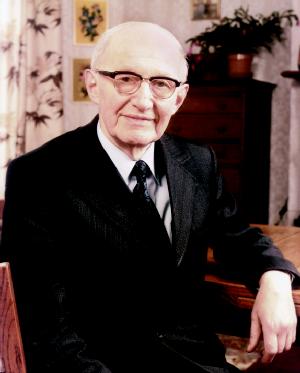| 2002 |

|
YEAR BOOK |
|
Ulster genius
|

On the facing page, some of the highly commendable efforts of today's Department of Education in Northern Ireland to support teachers and inspire a new generation of young scientists are outlined. I do hope that both teachers and students realise that there is a fine historical tradition of scientific and technological achievement in Northern Ireland? There was no mention of this when I learned science all those years ago in Belfast, in spite of being located at the centre of an area which has a particularly distinguished scientific record. I would like to see both science and history students (in the whole island of Ireland) learning about our science history: it would have the added advantage of helping to bridge the arts/science gap.
It is claimed by mathematicians, and with justification, that maths is the queen of the sciences. The premier University mathematics department in these islands in the nineteenth century was at Cambridge. The student who graduated in first place in mathematics there was called the "Senior Wrangler". William Thomson (1824�1907), later Lord Kelvin, was highly displeased when he was beaten into second place in 1845. But how many people realise that three other students from the Belfast area attained this high distinction in the space of one decade. Andrew Allen (1856�1923) won it in 1879, Joseph Larmor (1857�1942) in 1880, and William McFadden Orr (1866�1934) in 1888. Allen opted to become a vicar in England and Orr became a Professor in the Royal College of Science in Dublin.
William Thomson's father was a professor of mathematics at Belfast Academical Institution ('Inst'), though the family moved to Glasgow when William was eight years old. Thus Glasgow understandably claims him; not least because he was professor of natural philosophy (physics) there for a remarkable 53 years. But it is recognised by his biographers (Crosbie Smith & Norton Wise) that 'his enduring personal values were founded on the Irish context into which he had been born'. Reflecting Belfast's great industrial tradition, Thomson was no ivory tower scientist but, as the inscription to his statue in Belfast's Botanic Gardens puts it � 'he elucidated the laws of nature for the service of man'. There is not space here to do him justice, but we can note that he was the brains behind the first successful telegraph cable across the Atlantic in 1866, and the absolute scale of temperature is named after him. He went on to attain that supreme distinction in science, by being appointed President of the Royal Society (from 1890 to 1895), and receiving a peerage as Baron Kelvin of Largs in 1892. At least six Presidents of the Royal Society were of Irish birth � another Ulsterman was Sir Hans Sloane (from 1727�1741), the founder of the British Museum, who was born in Killyleagh, Co. Down.
Joseph Larmor (later Sir Joseph), actually born in Magheragall (near Lisburn), Co. Antrim, also achieved great distinction � he became Lucasian Professor of Mathematics at Cambridge from 1903 to 1932. This is the position held by Isaac Newton some time ago, and by Stephen Hawking today. Remarkably two men of Irish birth held this position for an amazing 83 successive years (1849�1932) � the other was George Gabriel Stokes (1819� 1903), another Irish Senior Wrangler (1841), although he came not from the Belfast area but from Screen, Co Sligo. Larmor is remembered chiefly for his work in the theory of electromagnetism, and for his seminal book Aether and Matter (1900). He was secretary of the Royal Society from 1901�1912.
Another Belfast scientific luminary was Thomas Andrews (1813�1885). Also a professor at Inst, he became founder Professor of Chemistry and Vice-President at Queen's College (now QUB). While there, he proved that ozone was a form of oxygen, but is remembered chiefly for his work on the liquefaction of gases � work which has had profound beneficial consequences for science and society.
Although he was not an academic, another local man who made technical innovations of profound influence was Harry Ferguson (1884�1960). Born in Growell (near Hillsborough), Co. Down, he developed the tractor, making it and its accessories both safe and cheap, with revolutionary consequences for world agriculture. No less than 517,649 'Wee Fergie' tractors were produced in the decade 1946�1956 alone, and the Welsh word for tractor is 'fergie'!
John Dunlop (1840�1921) was a Scotsman, but it was in Belfast that he developed the pneumatic tyre in 1887. Ernest Walton (1903�1995) was educated in Methodist College Belfast ('Methody'). He went on to split the atom in Cambridge in 1932, becoming the only Irish born recipient of a Nobel Prize for Science (he won the Physics Prize in 1951). Someone else who many think should have got the prize is Jocelyn Bell Burnell (born 1943), from Lurgan, Co. Armagh, who discovered pulsars (rotating neutron stars) in 1967.
This short article cannot do justice to the inventive scientific tradition of Belfast and its environs, a tradition which is not limited to Belfast, but to Ulster and all the provinces of Ireland. Young people who opt to study science are continuing in a long Irish tradition � and we can only hope that the recent downturn in the numbers of students choosing chemistry, physics and mathematics will soon be reversed to the great advantage of our island.
References
Wilbert Garvin & Des O'Rawe, Northern Ireland Scientists and Inventors, Blackstaff Press, 1993.
Charles Mollan, William Davis & Brendan Finucane (eds), Irish Innovators in Science and Technology, Royal Irish Academy, 2002.